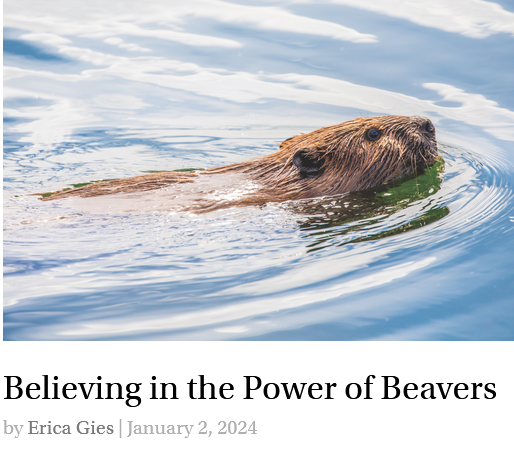If people get to the right answers anywhere first about beavers its going to be in Vermont. It looked like Utah and Washington might beat them for a while but the are speeding along at a great rate. It has a few head starts including being the home of on Skip Lisle inventor of the beaver deceiver and the man who has installed flow devices across the Northern Hemisphere.. And it’s own VDFW now installs flow devices itself. It has writers like Patti Smith of the beavers of Popples pond fame and years of education and rehab provided at the BEC Ecology center. Vermont might just be the place to be if you’re a beaver.
Restoring Vermont’s Beavers: The Cheapest Insurance to Reduce Damage from Climate Chaos
 Increasing the state’s beaver population can reduce some of the costs — social, environmental, and monetary — of lessening Vermont’s climate risks and can improve our state’s ecological health.
Increasing the state’s beaver population can reduce some of the costs — social, environmental, and monetary — of lessening Vermont’s climate risks and can improve our state’s ecological health.
Encouraging beavers in woodlands is inexpensive and can be implemented in a few years, versus decades. If we restore beaver populations, particularly at high elevations, beaver dams and canals will significantly reduce the risk of flooding and the cost of flooding that does happen, clean natural waterways, and enhance the abundance of animal and plant life that are part of the reason many of us live here.
Hows that for an opening paragraph. You may remember that Vermont suffered terrible flooding this year and suffered damages to the tune of 2,13 billion. That’s billion with a B and fixing things for the future to get ready for more ,climate changes will cost twice that much.
And beaver? What do they cost?
Recent articles in Scientific American and Science News reinforce older studies reported in books on the benefits of beavers. Beavers can be inexpensively reintroduced to public lands and — with owner approval — private property at little cost other than moving them there. Wildlife managers can investigate potential sites with a day visit and locate the pairs of beavers to sites that meet all their requirements This greatly reduces the chance that they will wander and build dams elsewhere.
Efficient Water Management
Beaver are efficient managers of flowing water, incidentally mitigating the effects of both floods and droughts, creating conditions that favor trout and other aquatic animals, providing dry-season water for all manner of creatures, and cleaning water before it is released from their dams. As beaver ponds age, trapped silt creates woodland meadows with rich, well-drained soil that provides habitat for all sorts of animals, some of which thrive nowhere else.
To the ecologist, beaver dams provide a stockpile of pioneer forest species that could not survive in the shade of a mature forest. For the fisherperson, they improve habitat by allowing cool, well-oxygenated flowing water with flow from dams that somehow do not block migrating fish such as trout and salmon. Beaver ponds purify water by allowing soil and pollutants to settle out and by stabilizing them, and store surface water and recharge ground water. For these and other reasons, beavers are considered a keystone species, one that increases the health and productivity of the whole ecosystem.
I hope you are all taking notes because the author of this article certainly did. Honestly this should be assigned reading in every flood control, fire department and civil planning division around the country.
Storing Water in the Ground
According to author Ben Goldfarb, researchers of beaver dams in eastern Washington found that a typical beaver dam stored “an average of 3 1⁄2 acre-feet free water and at least five times that figure below ground.” Some of that is water that might otherwise exacerbate a flood. It is not unusual for folks to notice that formerly reliable springs dry up when beavers have been trapped-out. Water conserved in hundreds of beaver dams adds up to huge volumes removed from flood potential without huge risks.
A Keystone Species
Because of their ecological importance, beavers are regarded as a “Keystone Species.” Their work in creating small clearings and managing water multiplies the diversity of plant and animal species as well as their general abundance. Unlike big dams on the rivers below, beaver dams do not require expensive public bonds. Storing smaller amounts of water in many beaver dams means that damage, if any, is minimal, if one dam fails. I have personally only seen beaver dams fail when abandoned (gradually) or dynamited by an impatient landowner (suddenly). Even the dynamited dam did not overflow the stream banks where I watched water race by.
Where Dams are Unwanted
Sometimes beavers dam water where flooding is inconvenient to people. The Vermont “Department of Fish and Wildlife has installed … (hundreds of) flow (management) devices since 2000 at a success rate approaching 90%” at inconvenient beaver dams, according to author Goldfarb. The other 10% require removal, of course, as will be necessary in a small percentage of cases. Overall, beavers decrease maintenance costs.
Where a dam that floods farm fields is judged useful by experts in river hydrology, the landowner might be recompensed with something like a conservation easement, received in years when the land is flooded. The practice could be extended to other situations on a case-by-case basis. The population of the state as a whole benefits from flood mitigation and water conservation. The small cost of such easements is negligible compared to the reduced costs of flooding.
Low-Cost Alternative to Geo-Engineering
Recently a proposal to create a floodplain to protect Waterbury has been revived. The plan calls for excavating as much of seven feet of soil to trap water that would otherwise contribute to flooding. When first proposed, following Tropical Storm Irene, the estimated cost was $3 million. Today it would cost more. The owner does not want to sell. Aside from objections to most uses of eminent domain, and I have some, such projects always risk unintended effects.
For a tiny fraction of the projected cost, reintroduction of beavers could protect the entire watershed, resulting in a system of dams and other water works that would slow water flows downhill; clean water; improve habitat for fish, game, other birds, mammals, reptiles, amphibians and insects; moderate all stream flow, low water as well as high; and reduce erosion. I suspect that 10% of the projected cost to mitigate flooding in Waterbury would be far more than what is needed to establish beaver-built flood mitigation for the entire Winooski watershed.
Good lord I feel like I need a cigarette after that articles and I never smoked. Dan hit all the good places and knocked it outta the park with that article. Remind me to send him a thank you note.









































